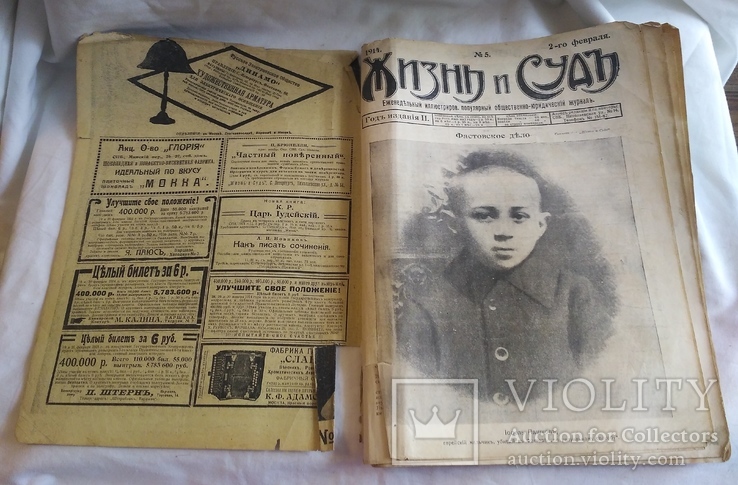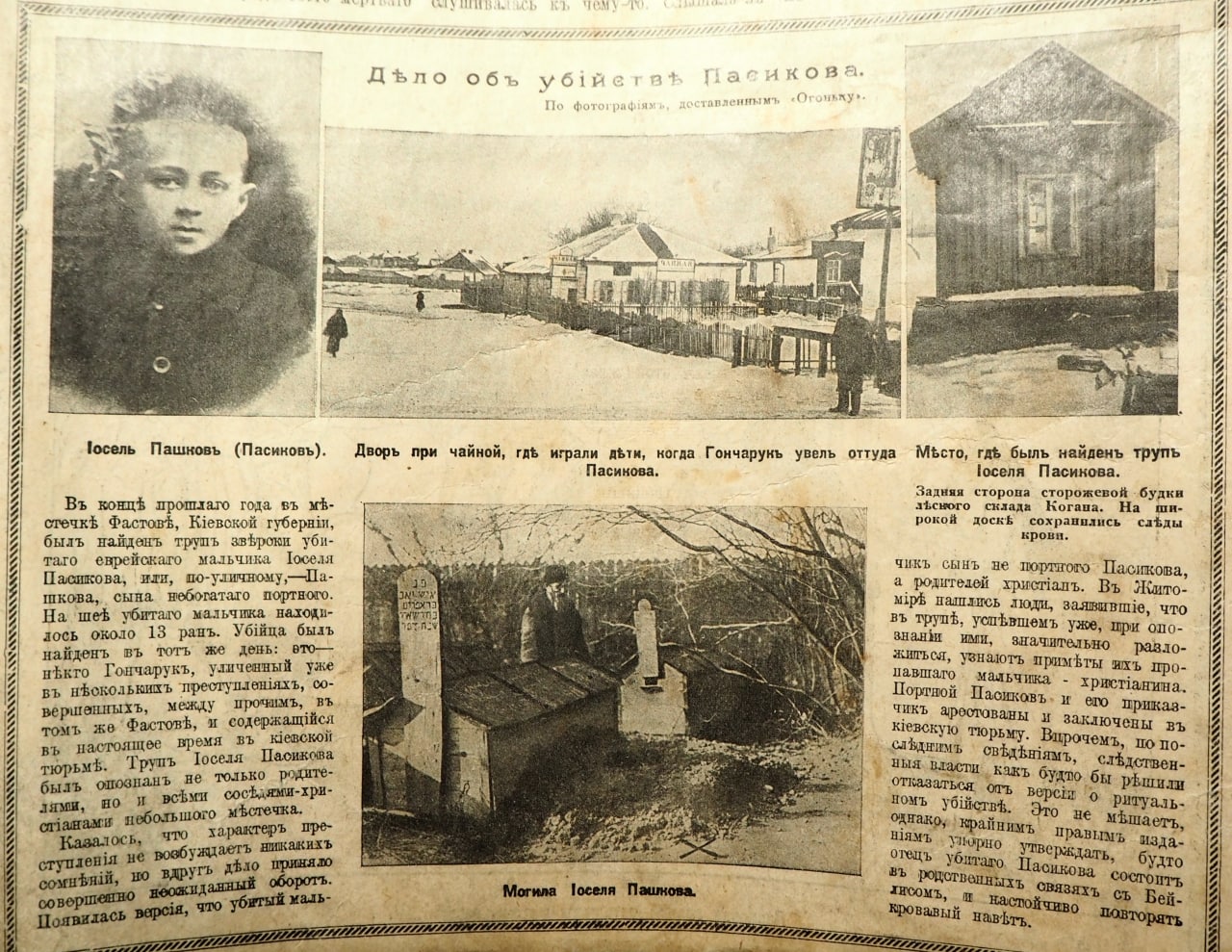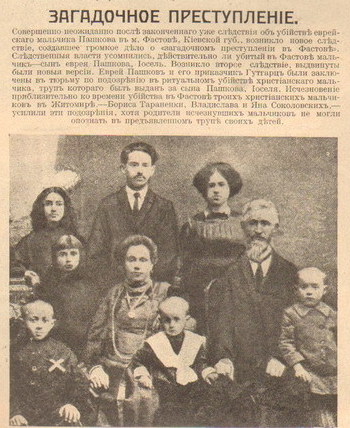Iosel Pasikov’s murder and the accusation that his father had killed a Christian child in a ritual murder was apparently big news in the Russian Empire in late 1913-early 1914. Stas Tarasov, my new genealogy friend and possibly a Ronen cousin, has found quite a bit of material on the case. For example, he found this full-page photo of Iosel on an internet auction site, www.auction.violity.com:

THE SCENE OF THE CRIME
Stas also found four photos related to the abduction of Iosel in the journal Ogoniok (No. 8, 1914). Note that the name “Pasikov” is sometimes Russified and spelled “Pashkov” in “street slang”:

The photo on the left is of Iosel Pashkov (Pasikov). This photo reappears in other publications and is most likely the one that the police in Fastov circulated in their attempt to stop Iosel from being smuggled across the border and out of Russia, as they alleged was likely to happen.
The center photo shows the playground next to the tea house where Iosel and other children were playing when he was kidnapped by the murderer, Goncharuk.
The photo on the right shows the back of the guard booth of the wood storage of Kogan [perhaps a yard where wood was stored by someone named Kogan], where Iosel’s body was found with 13 stab wounds in his neck. Blood stains were found on the widest plank.
The photo at the bottom shows Iosel Pashkov’s grave. Based on a family photo the man is clearly his father, Froim Pashkov. It is unclear to me whether Iosel’s grave is the one in the front or the smaller one in the back; however, Froim is standing at the head of the smaller grave, which makes it the likely candidate.
“About the Killing of Pashkov”
At the end of last year, in the town of Fastov, Kyiv province, the corpse of a brutally murdered Jewish boy, Iosel Pasikov, or, in the street slang, Pashkov, the son of a poor tailor, was found. There were about 13 wounds on the neck of the murdered boy. The killer was found on the same day: this is a certain Goncharuk, convicted of several crimes committed, by the way, in the same Fastov, and is currently being held in a Kyiv prison. The corpse of Iosel Pasikov was identified not only by his parents, but also by all the Christian neighbors of a small town.
It seemed that the nature of the crime did not raise any doubts, but suddenly the case took a completely unexpected turn. A version appeared that the murdered boy was not the son of the tailor Pasikov, but of the Christian parents. In Zhytomyr, there were people who declared that in the corpse, which had already, upon identification by them, significantly decomposed, they would recognize the signs of their missing Christian boy. The tailor Pasikov and his clerk are arrested and imprisoned in Kyiv. However, according to the latest information, the investigating authorities seem to have decided to abandon the version of the ritual murder. This does not prevent, however, the extreme right-wing publications from stubbornly asserting that the father of the murdered Pasikov is related to Beilis, and persistently repeating the blood libel.
THE PASHKOV (PASIKOV) FAMILY
The Internet also offered up this precious family portrait:

“Mysterious Crime”
Quite unexpectedly, already after the closed investigation into the murder of the Jewish boy Pashkov, in the townlet Fastov of the Kiev Governorate, a new investigation took off creating a resonant case about “the mysterious crime in Fastov.” The investigative authorities started questioning whether the murdered boy in Fastov was, indeed, Jew Pashkov’s son Iosel’. A new investigation was opened, and new versions were proposed. Jew Pashkov and his counterman Guthartz were incarcerated on suspicions of the ritual murder of a Christian boy, whose body was presented as Pashkov’s son, Iosel’. The disappearance, close to the murder in Fastov, of three Christian boys in Zhitomir – Boris Taranenko, Vladislav, and Ian Sokolovsky– strengthened these suspicions, though the parents of the disappeared boys couldn’t identify their children in the body they were presented with.
This family portrait of the Pasikov (Pashkov) family would have been taken some time before Iosel’s murder at the age of 11 or 12 in November 1913. Iosel is seated in front on the left and marked with an “X.” We can easily identify the father Froim and his wife, Basheva.
As for the rest of the children, in 1897 the Russian Census Revision listed three children: Zalkin, age eight, Sarah, age four and Leiba, a one and a half-year-old son. If Iosel was ten years old in the photo above, it would have been taken in about 1911, making Zalkin 21 or 22, Sarah about 17 and Leibe about 14 in the photograph. You can see the census original here.
The young man in the back, center is likely the eldest child, Zalman (Zalkin), and I’m guessing that the young woman in the back, right is Sarah. The Battalen-Ronen letters refer to a “Nechamka in Fastov,” which could be the daughter in the back, left. There doesn’t seem to be a boy of about 14 years; perhaps Leibe had died.
HOW IS THIS FAMILY RELEVANT TO US?
In brief, they are our relatives on the Ronen side, probably through Chana Ronen. We know from the Battalen-Ronen letters that the family had “an uncle in Fastov.” The details of the murder and ritual murder accusation that Nechamka Ronen wrote about to her sister Fenya in New York are corroborated by contemporary news reports; therefore, we can be confident that the Pashkov case is indeed our family’s story. Read Nechamka Ronen’s letter and how its facts were corroborated.
Chana Ronen, our great-grandmother and Fannie Ronen’s mother, was likely the sister either of Froim Zalmanov Pashkov or of his wife, Basheva Srul-Gershokova Pashkova. Having different patronymics, Basheva and our great-grandfather Meier Yankelovich Ronen did not have the same father, though they might have had the same mother. Until we know either Basheva’s or Chana’s maiden names, or Chana’s patronymic, we can’t be sure on which side we are related.
PUBLIC FIGURES INTERESTED IN THE PASHKOV AFFAIR
There are the instances of public figures making reference to or being influenced by the Pashkov murder and ritual murder accusation.
One was An-sky, the author of the famous Yiddish play, “The Dybbuk.” Professor Gabriella Safran (Stanford University) wrote about the early 20th century ethnographer Shloyme-Zanvl Rappoport, who was better known by his pseudonym, An-sky, in her book, Wandering Soul: The Dybbuk’s Creator, S. An-sky (Harvard University Press, 2010). She comments regarding the Pashkov case, that “The liberal and radical press reported the case in detail” (p. 211). An-sky was terribly affected by the Beilis ritual murder case, which was tried in Kiev and produced a verdict of “not guilty” a short month before Iosel’s murder. An-sky went to Fastov to research the Pashkov affair for an article for the publication Rech’. Safran asserts that, in his despair over the wretched state of Russian-Jewish relationships which both these cases revealed, he wrote what has become one of the most famous Yiddish plays, “The Dybbuk.” This is not to say that the Pashkov affair directly influenced the writing of the “The Dybbuk,” rather that its author was intimately familiar with the case, which may have contributed to his state of mind at the time.
Stas Tarasov also discovered a book by A.S. Tager, “Tsarist Russia and the Beilis Case,” published by Soviet Legislation, Moscow, 1934, pp. 287-292, Section IV. It mentions An-sky’s trip to Fastov and the article he wrote, which “…directly and point-blank raised the question of a new, staged ritual murder…” (italics added). By the way, this is the same book the translation of which, published by the Jewish Publication Society of America in 1935, I had found earlier, and which described the plot to falsely accuse Froim Pashkov of ritual murder.
The book also mentions contemporary anti-Semitic agitation by the All-Russia National Union, a conservative political party founded in 1908. In that regard, none other than Lenin himself had something to say about the Pashkov affair:
“In connection with the intensifying agitation of the All-Russian National Union, V. I. Lenin also drew attention to this attempt to ‘arrange a second Beilis case’ in his time: ‘It would be a big mistake to think that the significance of this agitation is insignificant and fictitious … Insignificant and illusory.’ ” (p. 287)
It is this intersection of our personal family history with real historical events and movements that breathes life and meaning into my genealogical research and that takes it far beyond names, dates and locations.
Thanks to Stas Tarasov for translating the Russian articles in this post.
Always fascinating. Thank you.